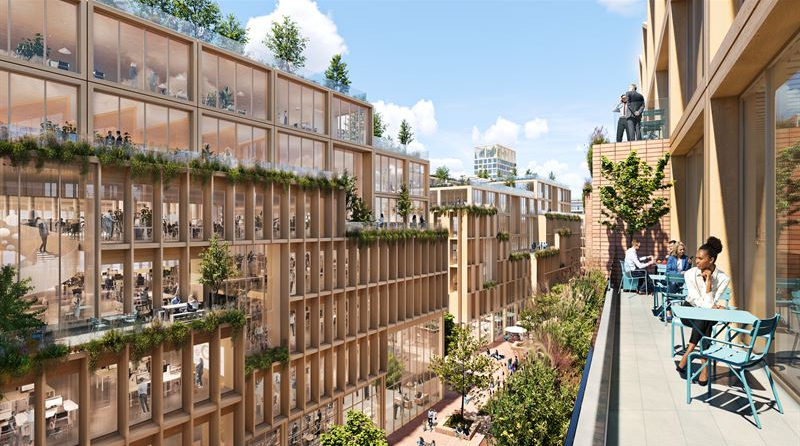
©Atrium Ljungberg / Henning Larsen
Vocabulary:
- initiative /ih-NISH-uh-tiv/
- predominantly /pri-DOM-uh-nuhnt-lee/
- sustainability /suh-stey-nuh-BIL-i-tee/
- collaboration /kuh-lab-uh-REY-shuhn/
- transportation /trans-per-TEY-shuhn/
[noun] – a new plan or process to achieve something or solve a problem
The school introduced a literacy initiative to improve reading and writing skills among students.
[adverb] – mostly or mainly
The restaurant’s menu features predominantly vegetarian options, catering to customers with plant-based diets.
[noun] – the quality of being able to continue over a period of time
The company is committed to sustainability and has implemented various eco-friendly practices, such as recycling and using renewable energy sources.
[noun] – the situation of two or more people working together to create or achieve the same thing
The healthcare providers formed a collaboration to improve patient care and share best practices.
[noun] – a vehicle or system of vehicles, such as buses, trains, etc. for getting from one place to another
The government implemented policies to promote sustainable transportation, such as incentivizing the use of electric vehicles.
Article reading:
The project is a collaboration between the Stockholm Municipality and architecture firm White Arkitekter, who have designed a master plan that emphasizes sustainability and promotes a sense of community. The wooden structures will not only reduce the carbon footprint associated with traditional construction materials but also provide a warm and natural aesthetic that enhances the overall livability of the area. Slakthusområdet will feature a range of amenities, including residential buildings, offices, commercial spaces, and public areas. The district’s design aims to prioritize walkability, green spaces, and sustainable transportation options, fostering a sense of well-being and connectivity among residents and visitors. The use of wood in construction is gaining popularity globally as a sustainable alternative to concrete and steel, which have significant environmental impacts. Wood is a renewable resource that can store carbon dioxide, helping to mitigate climate change. The project in Stockholm aligns with the city’s commitment to carbon neutrality and represents a progressive step towards more sustainable urban development. By building the world’s largest wooden city, Stockholm not only showcases its dedication to sustainable practices but also sets an example for other cities around the world to follow. The project demonstrates the possibilities of combining modern design, environmental responsibility, and livability in urban areas.
Discussion Questions:
- What benefits do you think a wooden city can bring in terms of aesthetics and livability?
- How do you feel about the concept of building a large wooden city in Stockholm?
- Do you think using wood as the primary construction material is an effective way to promote sustainability in urban development?
- How important is it for cities to prioritize sustainable transportation options and green spaces in urban planning?
- Do you believe projects like the world’s largest wooden city in Stockholm can inspire other cities to embrace sustainable architectural practices? How?
Summarization
Describe:
- urban development
- aesthetic
- livability
- walkability
- amenities